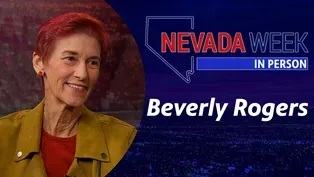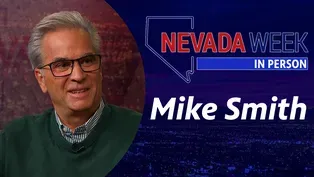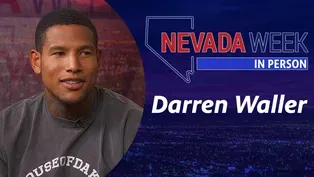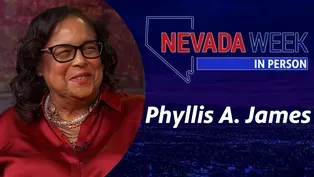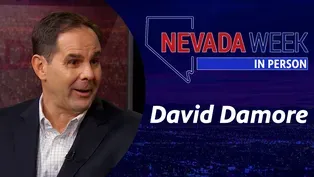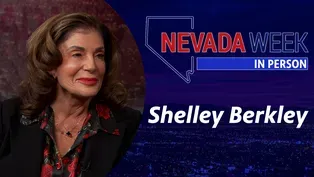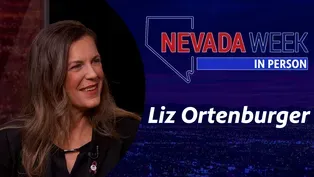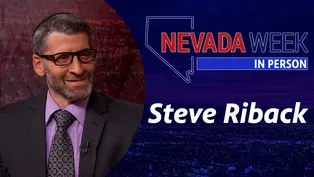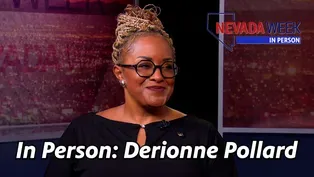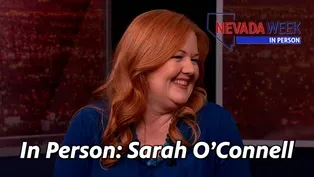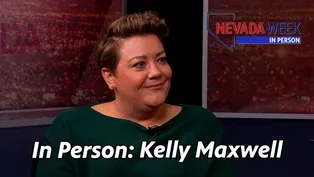
Nevada Week In Person | Alisha Kerlin
Season 1 Episode 13 | 14mVideo has Closed Captions
A one-on-one interview with Alisha Kerlin, executive director of the Barrick Museum.
A one-on-one interview with Alisha Kerlin, executive director of the Barrick Museum at UNLV.
Problems with Closed Captions? Closed Captioning Feedback
Problems with Closed Captions? Closed Captioning Feedback
Nevada Week In Person is a local public television program presented by Vegas PBS

Nevada Week In Person | Alisha Kerlin
Season 1 Episode 13 | 14mVideo has Closed Captions
A one-on-one interview with Alisha Kerlin, executive director of the Barrick Museum at UNLV.
Problems with Closed Captions? Closed Captioning Feedback
How to Watch Nevada Week In Person
Nevada Week In Person is available to stream on pbs.org and the free PBS App, available on iPhone, Apple TV, Android TV, Android smartphones, Amazon Fire TV, Amazon Fire Tablet, Roku, Samsung Smart TV, and Vizio.
Providing Support for PBS.org
Learn Moreabout PBS online sponsorshipMore from This Collection
Nevada Week In Person | Beverly Rogers
Video has Closed Captions
One-on-one interview with Rogers Foundation chair Beverly Rogers. (14m)
Nevada Week In Person | Mike Smith
Video has Closed Captions
One-on-one interview with Las Vegas Sun political cartoonist Mike Smith. (14m)
Nevada Week In Person | Jon Ralston
Video has Closed Captions
One-on-one interview with The Nevada Independent CEO Jon Ralston. (14m)
Nevada Week In Person | Darren Waller
Video has Closed Captions
One-on-one interview with Las Vegas Raider tight end Darren Waller. (14m)
Nevada Week In Person | Phyllis A. James
Video has Closed Captions
One-on-one interview Phyllis A. James. (14m)
Nevada Week In Person | David Damore
Video has Closed Captions
One-on-one interview with Chair of the Department of Political Science at UNLV David Damor (14m)
Nevada Week In Person | Shelley Berkley
Video has Closed Captions
One-on-one interview Senior Vice President for Touro University Shelley Berkley. (14m)
Nevada Week In Person | Liz Ortenburger
Video has Closed Captions
One-on-one interview with SafeNest CEO Liz Ortenburger. (14m)
Nevada Week In Person | Steve Riback
Video has Closed Captions
One-on-one interview with Las Vegas Metro Police Lieutenant Steve Riback. (14m)
Nevada Week In Person | DeRionne Pollard
Video has Closed Captions
One-on-one interview Nevada State College President DeRionne Pollard. (14m)
Nevada Week In Person | Sarah O’Connell
Video has Closed Captions
One-on-one interview with Director of Eat More Art LLC Sarah O’Connell. (14m)
Nevada Week In Person | Kelly Maxwell
Video has Closed Captions
One-on-one interview with Baby’s Bounty Executive Director Kelly Maxwell. (14m)
Providing Support for PBS.org
Learn Moreabout PBS online sponsorshipWe're chatting with the executive director of the Marjorie Barrick Museum of Art on UNLV's campus.
That's this week on Nevada Week In Person.
♪♪♪ Support for Nevada Week In Person is provided by Senator William H. Hernstadt and additional supporting sponsors.
(Kipp Ortenburger) From artist in residence at UNLV to curator of the Barrick Museum to executive director, one might say Alisha Kerlin checks all the boxes for leading a museum of art, but Alisha many times can be found working outside the box with respect to what a traditional art museum is and does from exhibiting and supporting local artists to increasing access to the museum for school kids.
I very much welcome Alisha to talk about some of the moves that she's made here at the Barrick Museum and just in the art community in general.
Thank you so much for being here.
We really appreciate it.
-Thank you.
Can I use that intro for my bio?
I like that.
-If you want to, thank you.
I wrote that, so that's wonderful.
Thank you very much for that.
I want to jump into this right away, and I want to talk a little bit about I read in your bio that one of your big priorities is removing barriers to access of art.
I want to talk to you first about what are some of those key barriers that you see first off?
(Alisha Kerlin) One, I think it is that people don't see that an art museum could be for them.
You know, maybe they haven't been before, maybe they don't know how to behave in an art museum, right?
Just having access to an art museum in Las Vegas with us being the only one is important.
And money, too.
We're the only free museum that I know of in Las Vegas and we're the only art museum, so anybody's welcome to come to the Barrick and to UNLV; it's an open campus.
So having access to art that isn't trying to sell you something, that maybe is trying to ask you to bring yourself to it so you're able to learn and teach us about yourself, that's what the Barrick does, and there's not a lot of other places to access that.
-It's a great point.
I want to come back to the etiquette piece of this, because it really-- I mean, I assume there's an etiquette.
I mean, there's an etiquette I follow when you go to an art museum particularly.
Is it something that you can teach?
I'm thinking of school kids coming to a museum the first time.
-Okay.
We love that school kids, most likely it's their first time.
But also college students, it's their first time as well because maybe they grew up in Vegas and they didn't have access to an art museum.
You can teach it, but we don't shame it away, and we don't walk around and tell people why something is important.
We don't say oh, this is just spinach and you should eat it because it's good for you.
We want to hear what they're responding to so we don't-- you know, there's really not a right way to be around art.
Please don't break it, hang your coat on it, touch it if it's not allowed.
But we're very much into taking down that, you know, religious experience of going into an art museum, you must be quiet.
We want people to be laughing, be activated by the art that they see.
-Well, that's interesting because you typically regard a piece of art-- at least this is what I've always thought etiquette is-- and you kind of internally are going through the dialogue of what the piece means to you and what it might mean and what the artist meant and things like that, and it really does prevent an opportunity of you looking to your side and saying, I mean, this is really-- you know, this is bringing up a lot of emotion to me; what's it doing for you?
I mean, is that what you're trying to do at the museum?
-Yes.
It's a place to be social and talk to others or it's a place to get some quiet, however you want to interact with it.
But we do expect and we want to normalize that you may have feelings.
It may make you think about your own life.
You may cry, you may laugh, you may go why is this art, you know.
And that's welcome in the space, especially in an educational setting.
We're prepared to have that dialogue, and we actually encourage it.
-The exhibits at the museum too.
I went several years ago, I think before your tenure as executive director, and there was, I would say, more traditional art.
It's changed a lot.
I was there during the Artwalk, and the museum has really shifted.
What's the point of that shift?
-I'm glad you came.
It was a busy, busy time.
Well, when the pandemic hit, we realized that we were one of the more stable art places in town.
We will survive this.
So we opened up the space, divided it into multiple sections to allow different stories and perspectives to be told.
So when you really are listening to the people that live in the city and the people who are making art in this city, you'll find that a painting on the wall, you know, could be completely appropriate for that story and sometimes it's not.
Sometimes it's a blueprint printed at Kinko's because that's the type of texture and story that needs to be told.
Sometimes the wall is painted like your grandmother's linoleum, giant 10 feet tall, because that's important to the story that curator wanted to tell.
So you're going to see very different mediums and installs.
There's something for everybody there because of that, because what we do is we lift up what artists want, right?
I don't have the authority, nor really does anyone, to say this is the right way to show art.
You know, there's rules in every facet of our lives.
Why can't a university art museum just break the rules a little bit?
-Break the rules.
-You know, be open.
-An interesting thing about supporting artists too, being open like that is one way to support artists.
I want to come back to not just the museum but more the community side of this.
Your grade on how well our community does in supporting local artists, what kind of grade would you give us?
-Well, one, I would say which community?
The community of teachers like Clark County School District?
The community of instructors full-on support the museum, and that support is not money.
Sometimes they do.
You know, if it's K-12, we've seen tons of support.
But in terms of businesses, casino support, not so much.
Recently I met with the Cosmopolitan and they funded a four-year scholarship for an artist.
That was kind of like you saw the responses on social media and it was like wow, everybody needs to do this.
That's a huge deal.
You know, they're really investing in the arts, someone's future, you know, and they're getting a mural out of it.
They wanted this person to tell the story about Las Vegas, the diversity of Las Vegas and this creative city.
So long answer, it's not a grade.
It's more like let's see what other areas of this city could help sustain the arts here.
-What do you think is missing there?
Let's talk a little bit about the corporate side, and I don't want to just draw attention to gaming casinos.
We have a lot of other businesses here as well.
But what do you think is missing from maybe some of those businesses seeing the philanthropic or maybe even more of the social or economic benefits of art and supporting local artists?
-Maybe the people who grew up in Las Vegas didn't have the field trip to the museum, and they don't know.
They don't have the experience maybe of the value of a museum, right?
They could be sitting on boards that judge grants even.
Also our collection is held in a public trust, and we've had people say want to visit a more private collection, but there's no guide and you also have to pay something to go see it.
At the museum, we're supposed to show it to you.
We're supposed to go out of our way to show you the work that we hold in the public's trust, and we're for the people.
So maybe there's just a lack of knowledge of what that support could look like.
You know, it could be loaning furniture for a care room for example, paying for one bus to visit the museum so our city grows up knowing about the arts.
It doesn't have to be the multimillion dollar endowment-- that would be nice-- but every little penny and every little gift in kind or volunteering goes a long way, and not just at the museum, for like little experimental theaters and the little studios and artists living here.
-Yes, because of course I want to come to this and your own personal art experience is you don't need a ton of money necessarily to support art itself; of course maybe an artist, their lives of course, and I want to come to that also.
You have said you're an artist first.
As we've just been talking about, your executive director speak here comes work, right?
But I mean, how do you balance those two things because you are as you say artist first that is an executive director.
How are you able to balance both of those sides of your life, if that makes sense.
-Hmmm.
A lot of work.
The same time I took this leadership role, I also became a mother and I experienced imposter syndrome along all those roles.
Motherhood, executive director, you know, and an artist.
You know, can I make space for myself as an artist if my role in this community is to take care of artists and support and lift up other artists?
So I've done a lot of work and it wasn't easy, but I know that art is who I am, and I need to make space for that.
Is it balanced?
Absolutely not.
-But have you been able to make space for art?
-I've been able to make space whether it's at my kitchen table or it's, you know, taking a walk for example could be part of a practice and communicating with those that I feel most comfortable being creative around.
But yes, the literal space could be small, and the time could be 15 minutes.
-Yes, and I want to bring attention to that too because I did read that your breakfast table is your studio; your canvas, interestingly enough is junk mail.
I thought that really interesting.
And then your inspirations really are these little snippets of conversations you have with your family and then through your work day.
I mean, how do you combine those three, or why is that kind of your medium?
-When I lived in New York-- I lived in New York prior-- I was a big oil painter.
I came to Vegas and that didn't make sense anymore to me, and I love those grocery ads, and I had a lot of them.
The pandemic was-- so I started painting on the junk mail, and I liked the way it felt.
It felt culturally right to me, it was available, and it could be thrown away easily if it didn't work out.
So if I'm on a Zoom call, I might write down something you said, or if my daughter's watching a TV show, I might write down a line, you know, or with this conversation, I'll probably head to my car and make a little note, and that might surface up like fat rising to the surface of a soup and make its way into a painting.
(laughter) -Got it.
I'm trying to put the analogy of fat rising in the soup with your experience here on the show.
We'll talk about that I think afterwards.
-I don't really cook, so I shouldn't use that.
-A couple of short questions here.
A true Las Vegas experience is for you... -I think going way out to the desert and then coming back and having like a world-class meal or visiting the Strip.
Like those extremes.
-Those extremes, absolutely, and so many different contrasts that we could list here.
The next big thing in Las Vegas will be... -I hope it's more space for artists to make art.
Like it's someone coming through and making studio space for people to do things in non-commercial ways.
I think I'm hearing a lot.
I think that'll be the next big thing.
-That's great, and per the conversation we had on the regular Nevada Week about those types of installations too.
Best thing you'd like to do on a weekend.
You can't use the same answer you already used.
-I garden.
-Gardening?
Really?
-Yes.
I'm growing seeds.
I have a bunch of raised beds, and I'm gardening.
And I could do that-- I could do that all day long every day.
I like to feed people and make chard bouquets.
It's the first time I've put roots in.
This girl that's traveled around finally put roots down in Vegas.
I get so much out of it.
-And I'm going to finish with that.
We have about a minute left.
You and I do share similarities there, that we were both supposed to be in Las Vegas for a very short amount of time.
You're here for five years, and I've been here for almost 10.
-I've been here for 10.
-Oh, you've been here for 10 too?
-Ten years.
March is 10 years.
-Wow.
So really quickly, what keeps you here beyond your job?
-I will never understand this city, and I'm not done with it.
Those contrasts that I explained, I have so much more to learn from the city, and I just love the people, the climate, everything about it.
-We're going to close on that.
That's great.
What a great statement.
-Thank you.
-Alisha, thank you so much.
-Thank you.
-We appreciate it.
Alisha joined us for a spirited conversation on immersive art experiences in Las Vegas on a previous episode entitled "Las Vegas and the New Art Experience," and you can view it by going to our website at vegaspbs.org/nevadaweek.
Support for PBS provided by:
Nevada Week In Person is a local public television program presented by Vegas PBS
